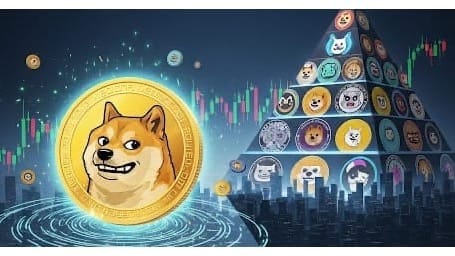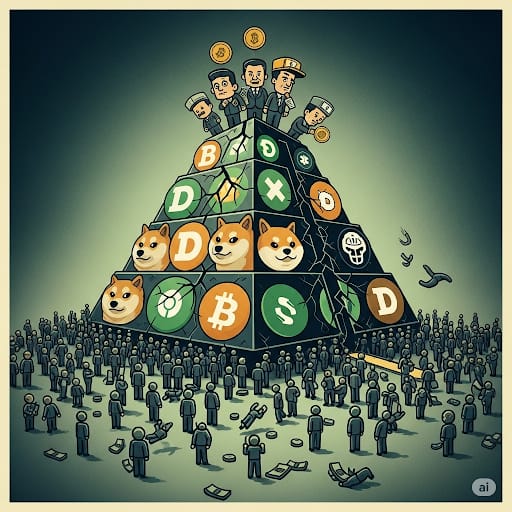Are memecoins pyramid schemes?

In recent years, I’ve witnessed the rise and fall of several crypto meme coins, which I now recognize as functioning very similarly to pyramid schemes. If you’re not familiar with meme coins, let me give you a quick crash course. Before diving into how people use these tokens to make or lose money, it’s important to understand what meme coins are. Meme coins are fungible assets created on the blockchain. They’re like digital collector’s items, but unlike baseball cards, every token is exactly the same. If you buy 10 FartCoins at today’s market price, you can sell them at the current market price tomorrow—no token is more special than another. The most famous example is Dogecoin, a coin with a Shiba Inu dog as its logo. While not every meme coin is a scam some have built strong communities and survived for years many newer ones are pure schemes.
The rise of easier blockchain tools and platforms has made it incredibly simple to create and promote these coins. People—especially young investors are drawn in by the hype, the memes, and the dream of turning $100 into $10,000. You could call it gambling, or even MLM with extra steps. You hear about a coin from a tweet, a YouTube video, or a Telegram group. You buy it and hope someone else will pay more. That’s it. While these coins are marketed as fun and community-driven, many are created with one goal: to make early buyers rich by attracting a constant flow of new investors. Once the hype fades, most holders are left with worthless coins. You only profit when someone else buys in after you. That means, once you’ve invested, your incentive is to spread the word. Promotion relies on community hype and influencers. Everyone is incentivized to “recruit” others by posting on social media, shilling in group chats, or making memes to keep the hype alive. Like many MLMs, you buy in first and then you’re expected to become the marketing team. Eventually, you realize you were never part of a movement. You were the exit liquidity.
Unlike traditional products, meme coins usually have little or no intrinsic value. The price is purely speculative and fluctuates constantly sometimes swinging by double-digit percentages within seconds. There’s rarely any real product or service backing the coin just the promise that “if you buy now, someone else will buy it for more later.” In my experience, there was never a clear business model or long-term plan. I bought in thinking I was early. In reality, I was just someone else’s exit plan.
The creators always say the same things: “We’re working hard,” “Big things coming,” “Be patient.” They’ll never admit they’re paying for ads just to rise on tracking websites and dump on new buyers. As the creator, you don’t care about the price because you practically started with nothing. Any increase is profit. You might put in a $10,000 budget: $5,000 for liquidity (which you can withdraw later), $2,000 for advertising and a logo, and $3,000 to influencers—or better yet, give them free coins instead of cash. Now you haven’t spent anything, but the influencers have a personal stake in the coin’s success and will promote it even harder. It’s genius and free.

The “product,” if you can call it that, is just the coin itself—often named with humor, pop culture references, or cute branding. It doesn’t solve any real-world problem. The real product being sold is the dream: the fantasy of turning $50 into $50,000 overnight. These coins are marketed to young, risk-taking investors on platforms like Twitter, TikTok, and Discord—spaces where financial regulations are minimal or nonexistent. But I’d go even further and say you are the product. Millions of people chasing the same dream are the ones funding those dreams for a handful of early adopters. It’s just like the gold rush everyone wanted to find gold, but the ones who really made money were selling the shovels. The same applies here. Everyone wants to be the next meme coin millionaire, but very few understand that those millionaires exist because of the masses chasing the fantasy. In the end, it’s always a small group that controls the token supply and can sell at any time, triggering massive price dumps. Since they own most of the supply, they can pump and dump the coin at will to maximize their profit. It’s literally legalized theft. The people creating the coins take no real risk, while buyers walk away thinking of themselves as “early investors,” “risk-takers,” or “visionaries.” The only real label they’ll earn is “broke,” when their Hello Kitty Coin gets rug-pulled overnight.
As for placement, These meme coins are made available directly to retail investors through decentralized exchanges like Uniswap or PancakeSwap or Raydium. There’s no traditional placement strategy no stores, no regulation. It’s a digital free-for-all. What makes it worse is that these projects often target people in low-income countries or areas with poor financial literacy. When you only have $100 to invest, you’re not looking for a 10% return you’re dreaming of 10x gains. So people throw their money at shady tokens, fully knowing the odds are stacked against them. Because these tokens are available on decentralized platforms, there’s no need for an ID or KYC process. Unlike gambling websites, which might ask for a VPN or identity check, these meme coin exchanges are accessible to anyone with a phone and a wallet. That means from Argentina to Congo to Indonesia, people everywhere are getting pulled into the same internet based pyramid scheme. There’s no barrier not race, not religion, not geography. It’s a global scam disguised as a financial revolution.
Promotion is where the pyramid structure becomes most obvious. The more people who buy, the more the price rises and the more people fear missing out. In traditional MLMs, you at least get a commission for recruiting people. But in meme coins, you could recruit thousands, and still lose money. It’s a closed system. No value is created. One person’s profit is someone else’s loss. Influencers, YouTubers, and Telegram groups are used to build artificial hype. Once you’re in, you’re encouraged to spread the word. Not directly nobody tells you to go recruit but through posting memes, hashtags like “HODL” and “to the moon,” and the illusion that you’re part of something bigger. But really, everyone’s just trying to sell before someone else does. Eventually, the top holders usually the creators dump their bags. The coin crashes, and the community vanishes. No refunds, no accountability, just a deleted website and empty Discord server.
Although meme coins aren’t technically structured like traditional MLMs or pyramid schemes, the behavior, psychology, and outcomes are eerily similar. There’s no real product, the price depends entirely on constant recruitment, and most people lose money while a few early insiders walk away rich. Based on my own experience, I would absolutely consider many crypto meme coins to be modern digital pyramid schemes, hidden beneath internet culture, trendy logos, and false hope.
Comments ()